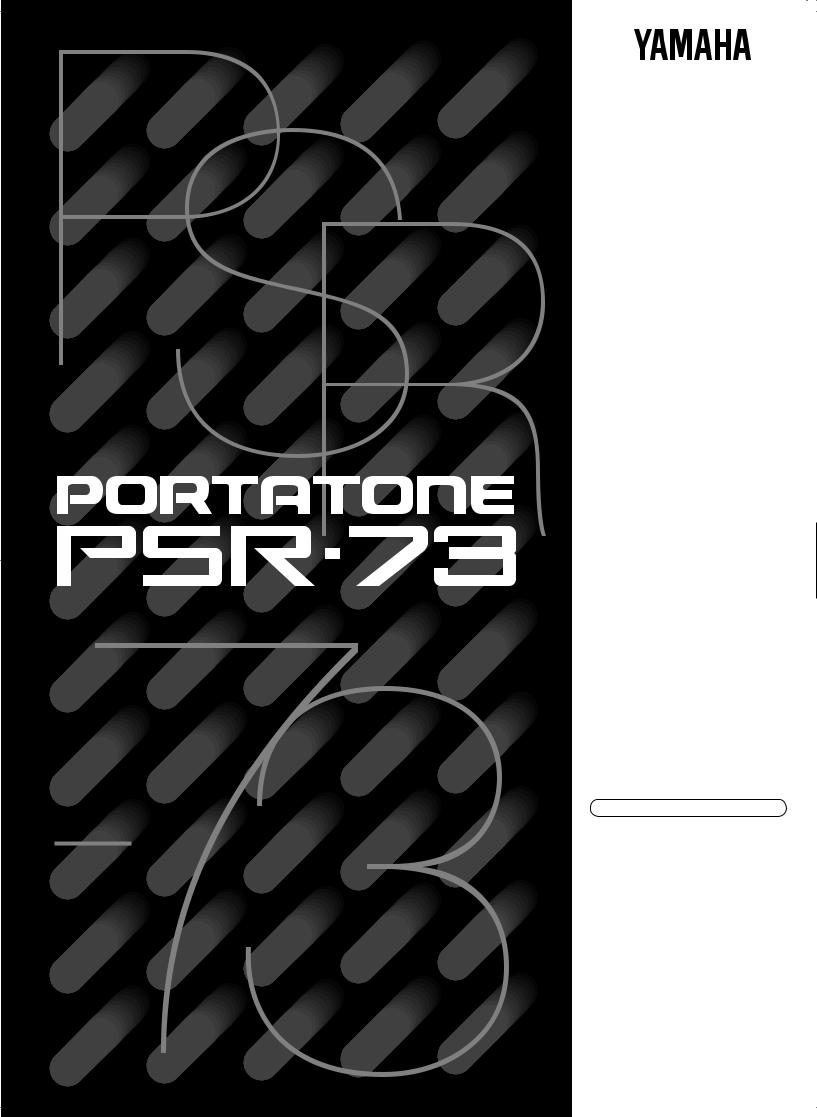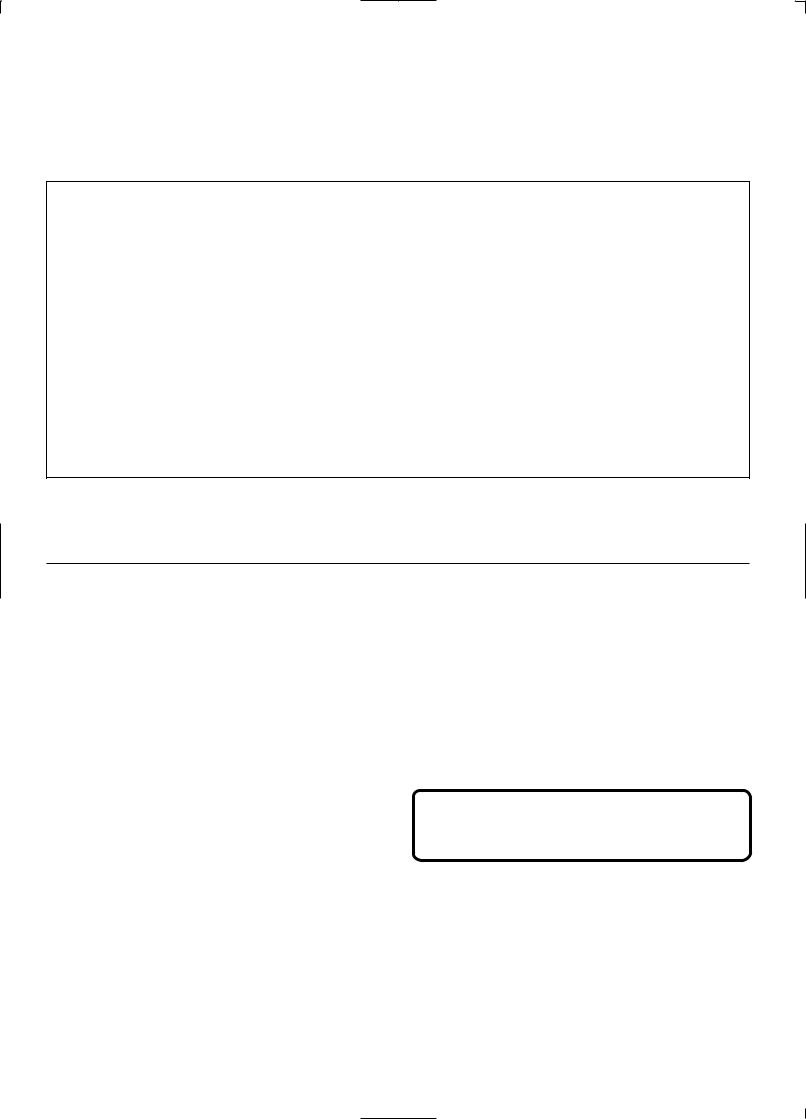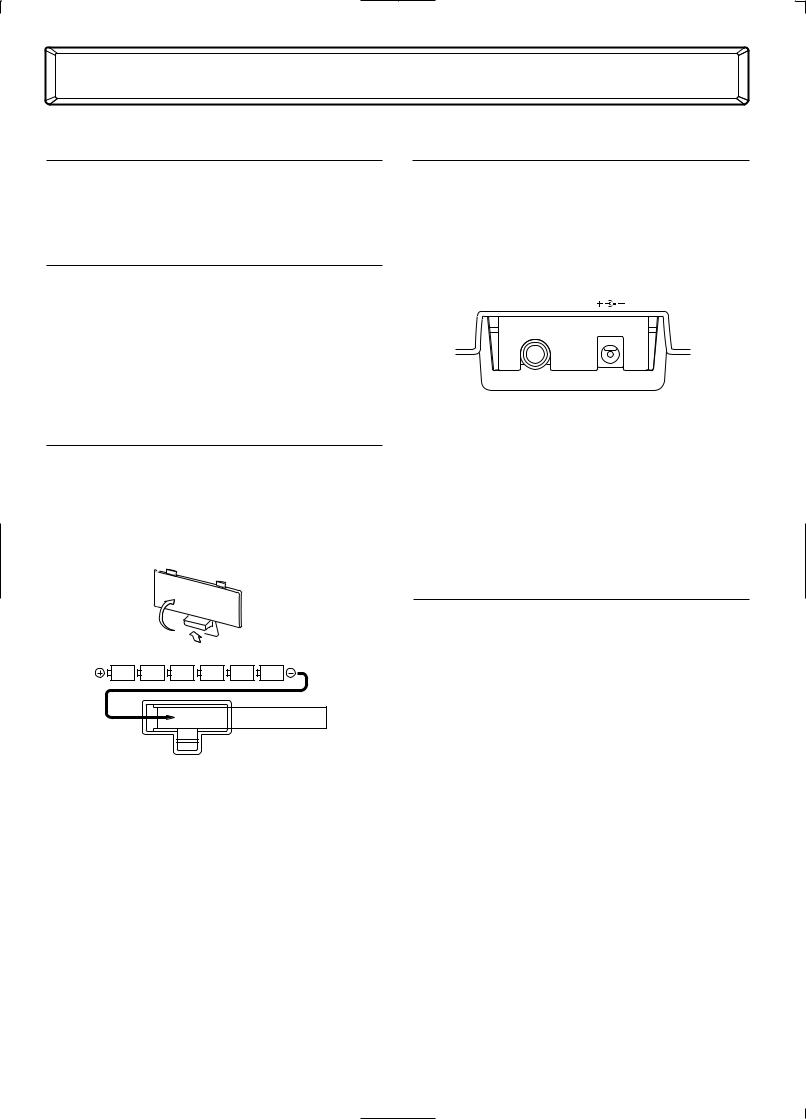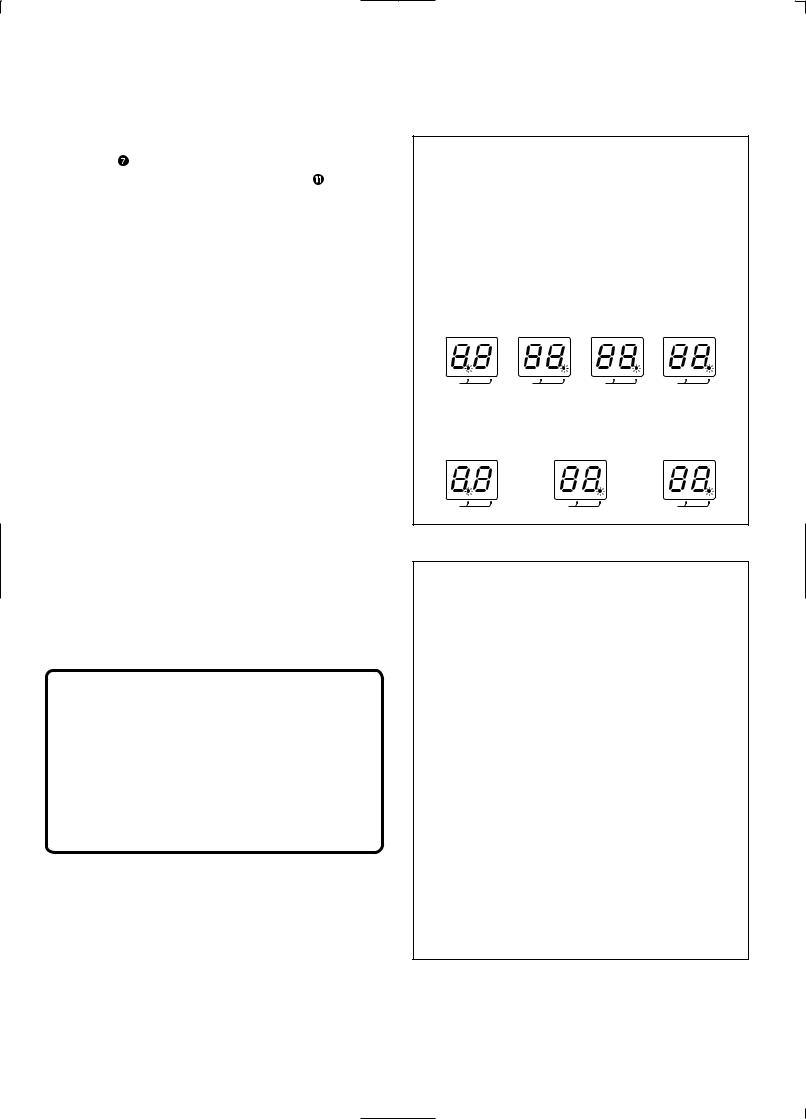Yamaha PSR-73, PSR-73E User Manual

OWNER S MANUAL
Contents |
|
Getting Started ............................. |
2 |
Playing Your New PortaTone ....... |
3 |
Voice Mode ................................... |
5 |
Style Mode .................................... |
6 |
Song Mode .................................... |
9 |
Troubleshooting ........................ |
10 |
Percussion Assign List |
|
(Voices 40 and 00) ...................... |
10 |
Jam Track Chord Progression List .... |
11 |
One Touch Settiing List .............. |
12 |
Song Scores ............................... |
13 |
Specifications ............................ |
23 |

Congratulations on your purchase of the Yamaha PortaTone
Y o u n o w o w n a p o r t a b l e k e y b o a r d t h a t p a c k s a d v a n c e d f u n c t i o n s a n d g r e a t s o u n d i n a h i g h l y c o m p a c t s i z e . I t s o u t s t a n d i n g f e a t u r e s a l s o m a k e i t a n e x c e p t i o n a l l y e x p r e s s i v e a n d v e r s a t i l e i n s t r u m e n t .
R e a d t h i s O w n e r ’ s M a n u a l c a r e f u l l y w h i l e p l a y i n g y o u r n e w P o r t a T o n e i n o r d e r t o t a k e f u l l a d v a n t a g e o f i t s v a r i o u s f e a t u r e s .
Main Features
T h e P o r t a T o n e i s a s o p h i s t i c a t e d m u s i c a l i n s t r u m e n t w i t h t h e f o l l o w i n g f e a t u r e s a n d f u n c t i o n s :
●Exceptionally realistic sounds with 100 AWM (Advanced Wave Memory) Voices, utilizing digital recordings of actual instruments.
●Dynamic, versatile rhythms and accompaniment with 100 music Styles.
●20 Songs, for listening enjoyment or for playing along with when using the Minus One function.
●20 Jam Track patterns, providing specially programmed rhythms and chord progressions for playing along with.
●One Touch Setting, for automatically calling up an appropriate Voice for playing with the Style, Song or Jam Track you select.
●High-quality amplifier/speaker system.
Precautions — Taking Care of Your PortaTone
Y o u r n e w P o r t a T o n e i s a f i n e m u s i c a l i n s t r u m e n t — a n d s h o u l d b e t r e a t e d a s s u c h . H a n d l e i t w i t h c a r e a n d c o m m o n s e n s e , a n d i t w i l l g i v e y o u y e a r s o f e n j o y m e n t .
Location
● Avoid exposure to direct sunlight or other sources of heat. Never leave it inside a car where it can get very hot. Also avoid highly humid or dusty places.
Interference From Electromagnetic Fields
●Do not use your PortaTone close to television sets, radios or similar equipment since this may cause interference noise in the other appliance.
Handling
●Protect your PortaTone from strong impact. Be careful not to drop it or place heavy objects on it.
Avoid applying excessive force to the controls and keys.
Cleaning
●Clean the exterior with a soft, dry cloth. To remove stubborn stains, use a slightly moistened cloth.
●Never use alcohol, thinner, or other chemical
solvents, since they will damage the finish. Also, do not leave vinyl chloride material on the PortaTone for a long time, since it may adhere to the exterior.
 NOTE
NOTE
Yamaha is not responsible for damage caused by improper usage.
When Not Using the PortaTone
●After use, always turn off the POWER switch. When not using your PortaTone for long periods, be sure to remove the batteries to avoid damage through battery leakage.
1

Getting Started
Power Requirements
Your PortaTone can run either on batteries (sold separately) or on normal household current by using the optional Yamaha PA-3/4/40 Power Adaptor.
Using an AC Power Adaptor
To connect your PortaTone to a wall socket, you will need the optionally available Yamaha PA-3/4/40 Power Adaptor. Use of other AC adaptors could result in damage to the instrument, so be sure to ask for the right kind. Plug the adaptor into a convenient wall outlet and its connector into the DC 10-12V IN jack on the back of your PortaTone.
AccessoryJacks
Using Headphones
For private practicing and playing without disturbing others, connect a set of stereo headphones to the rear panel HEADPHONES/AUX OUT jack. Sound from the built-in speaker system is automatically cut off when you insert a headphone plug into this jack.
HEADPHONES/ |
DC IN 10-12V |
AUX OUT |
|
Using Batteries
Inserting Batteries
Turn the instrument upside-down and remove the battery compartment lid. Insert six 1.5-volt size “D” batteries as shown in the illustration, making sure that the positive and negative terminals are properly aligned. Replace the lid.
When the Batteries Run Down
When the batteries run low and the battery voltage drops below a certain level, the PortaTone may not sound or function properly. As soon as this happens, replace them with a complete set of six new batteries. Never mix old and new or different types of batteries (e.g., alkaline and manganese).
AutoPowerOFF
The PSR-73 features an Auto Power OFF function that automatically turns the power OFF if the instrument is not used for approximately 30 minutes. This functions whether batteries or the AC power adaptor is used.
Connecting a Keyboard Amplifier or Stereo System
After making sure the PortaTone and any external devices are turned off, connect one end of a stereo audio cable to the LINE IN or AUX. IN jack(s) of the other device and the other end to the HEADPHONES/AUX OUT jack of the PortaTone.
The Music Stand
Insert the bottom edge of the music stand into the slot located at the top rear of the PSR-73 control panel.
2

Playing Your New PortaTone
T h i s s e c t i o n b r i e f l y s h o w s y o u h o w t o u s e t h e v a r i o u s c o n t r o l s o n t h e p a n e l o f t h e P o r t a T o n e .
1 |
5 |
|
|
|
11 |
POWER |
|
4 |
|
VOICE |
ON/OFF |
SONG |
||
|
||||
|
|
|||
2 |
1 2 3 |
|
DEMO |
|
|
|
MULTI DISPLAY
4 5 6
2 3
5 6
8 9
0 +
STYLE |
|
7 |
8 |
9 |
BEAT |
|
|
MINUS ONE |
|
3 |
|
|
||
– |
|
+ |
||
|
0 |
|||
|
– |
|
|
START/STOP |
|
|
|
|
|
|
+ |
TEMPO |
|
|
SYNC-START |
|
|
ONE TOUCH SETTING |
|
/FILL |
IN |
|
|
|
10 9
6
7
8
12 VOLUME
Turning on the Power
Press the POWER ON/OFF button  to turn on the power of the PortaTone. Whenever the power is turned on, Voice 01 (PIANO) is automatically selected.
to turn on the power of the PortaTone. Whenever the power is turned on, Voice 01 (PIANO) is automatically selected.
Selecting a Mode
Your PortaTone has three different operating modes: Voice, Style and Song — each selected from the corresponding panel buttons. VOICE  lets you select and play a Voice. STYLE
lets you select and play a Voice. STYLE  lets you select and play a setting that includes a rhythm/accompaniment pattern. SONG
lets you select and play a setting that includes a rhythm/accompaniment pattern. SONG  lets you select and play either a Song or a Jam Track pattern.
lets you select and play either a Song or a Jam Track pattern.
T o s e l e c t o n e o f t h e m o d e s :
Press the button corresponding to the desired mode. For now, press SONG  to select the Song mode.
to select the Song mode.
Playing a Song
in the Song Mode
A variety of Songs and special Jam Tracks have been recorded to your PortaTone to give you a taste of what you can do with the instrument, and to provide music and patterns for you to play along with.
T o s e l e c t a n d p l a y o n e o f t h e S o n g s :
1. With the Song mode selected, use the Numeric Keypad  to enter the desired Song or Jam Track number. Be sure to enter a two-digit number, as is printed next to each song on the panel. For example, to select Song 09, first press “0” on the Numeric Keypad, then “9.”
to enter the desired Song or Jam Track number. Be sure to enter a two-digit number, as is printed next to each song on the panel. For example, to select Song 09, first press “0” on the Numeric Keypad, then “9.”
You can also use the +/– buttons on the Numeric Keypad to step up or down through the preset numbers; holding down the appropriate button continuously changes the number. Note that the
+/– buttons have a “wrap around” feature. For example, pressing the + button from the last number returns to Song 01. (Song 01 is also
automatically selected when you turn the power on.)
3

2.To play the selected Song, press the START/ |
STOP |
button . |
|
Note that the dots in the MULTI DISPLAY |
flash |
in time with the music. The left dot flashes at the first beat of every measure, and the right dot
flashes at the other beats. (For more information on the MULTI DISPLAY, see box at right.)
3.Adjust the volume of the Song by using the VOLUME control  .
.
4.Although the Song is automatically set to play at a default tempo, you can change the speed of the Song by using the TEMPO buttons  . Press TEMPO + to increase the speed and TEMPO – to decrease it; holding down the appropriate button continuously increases/decreases the speed. (Note that the tempo value is briefly shown in the MULTI DISPLAY.)
. Press TEMPO + to increase the speed and TEMPO – to decrease it; holding down the appropriate button continuously increases/decreases the speed. (Note that the tempo value is briefly shown in the MULTI DISPLAY.)
If you want to set the tempo back to its original default setting, press both TEMPO buttons simultaneously. (For more information on the Tempo functions, see box at right.)
5.To stop the Song, press the START/STOP button  again.
again.
 NOTE
NOTE
You should enter numbers on the Numeric Keypad relatively quickly. If you do not enter the second digit of a number within about ten seconds after entering the first digit, the first digit will be cancelled. Entry of a first digit is also automatically cancelled if any other button on the panel (except for those on the Numeric Keypad) is pressed before entering the second digit. Also, keep in mind that entry of numbers higher than 40 in the Song mode are ignored.
AbouttheMULTIDISPLAY
As mentioned above, the dots in the MULTI DISPLAY flash in time with the rhythm, and the indication is used when a Song or Style plays back. This flashing provides a visual indication of both the tempo and the time signature of the rhythm.
For Songs and Styles in 4/4 time, the dots flash like this:
1st beat |
2nd beat |
3rd beat |
4th beat |
MULTI DISPLAY |
MULTI DISPLAY |
MULTI DISPLAY |
MULTI DISPLAY |
BEAT |
BEAT |
BEAT |
BEAT |
For Songs and Styles in 3/4 time, the dots flash like this:
1st beat |
2nd beat |
3rd beat |
MULTI DISPLAY |
MULTI DISPLAY |
MULTI DISPLAY |
BEAT |
BEAT |
BEAT |
About the Tempo Functions
T e m p o V a l u e s
As mentioned above, the tempo value is shown briefly in the MULTI DISPLAY when one of the TEMPO buttons is pressed. The displayed tempo range is from 10 to 60; in actual tempo values, the range is from 40 to 240 beats per minute. (Each step in the tempo adjustment corresponds to 4 beats per minute.)
D e f a u l t T e m p o s
Each Song and Style has been given a default or standard tempo. If you change the tempo, you can set it back to the original default setting, by pressing both TEMPO buttons simultaneously. Also, the tempo of a Song or Style returns to the default setting when selecting a different Song or Style. (The set tempo remains, however, when switching Styles during playback.) When you turn on the power of the PortaTone, the tempo is automatically set to the default setting of Style 01.
4
